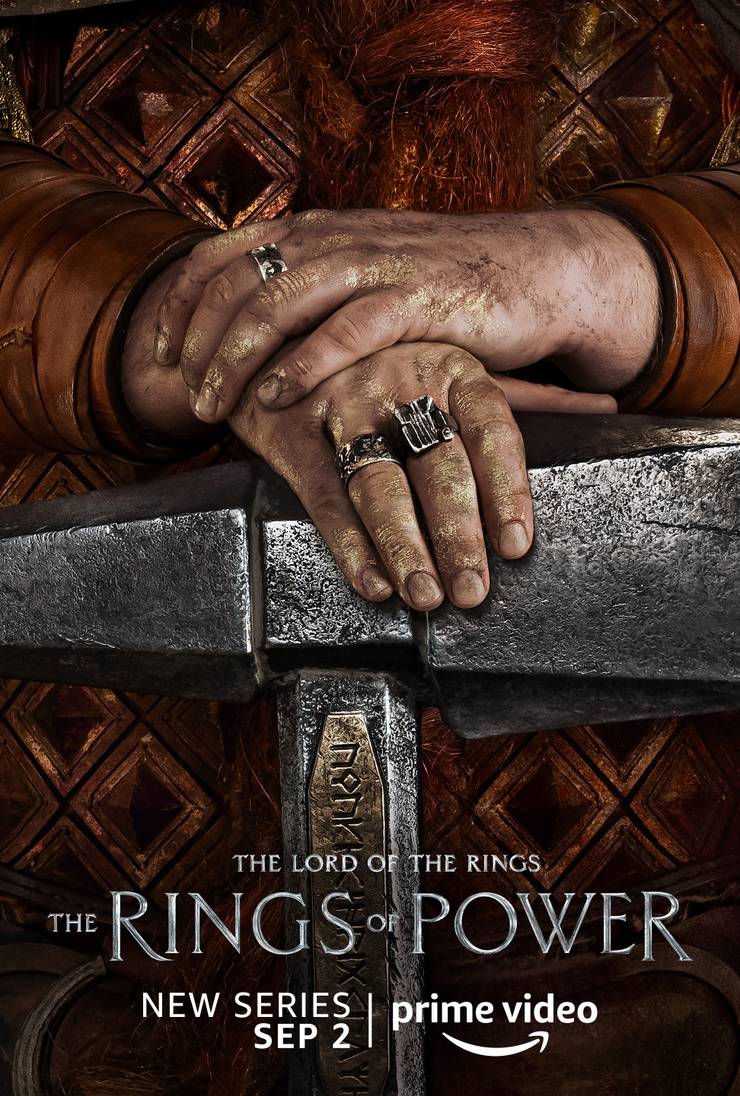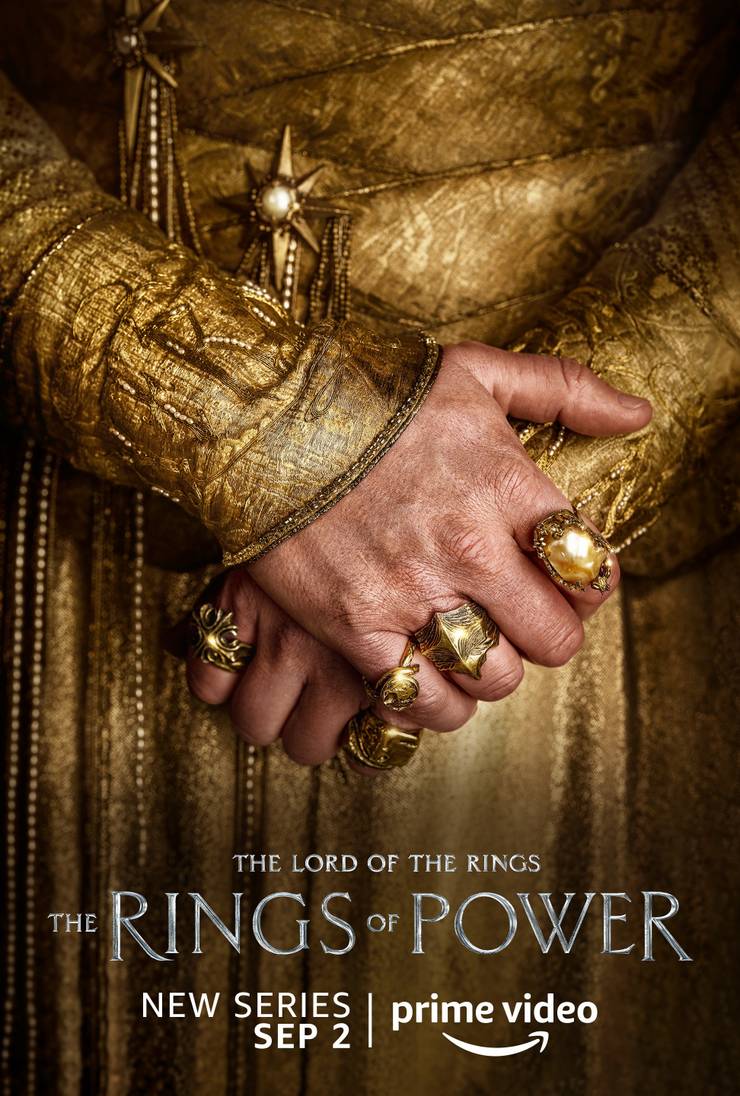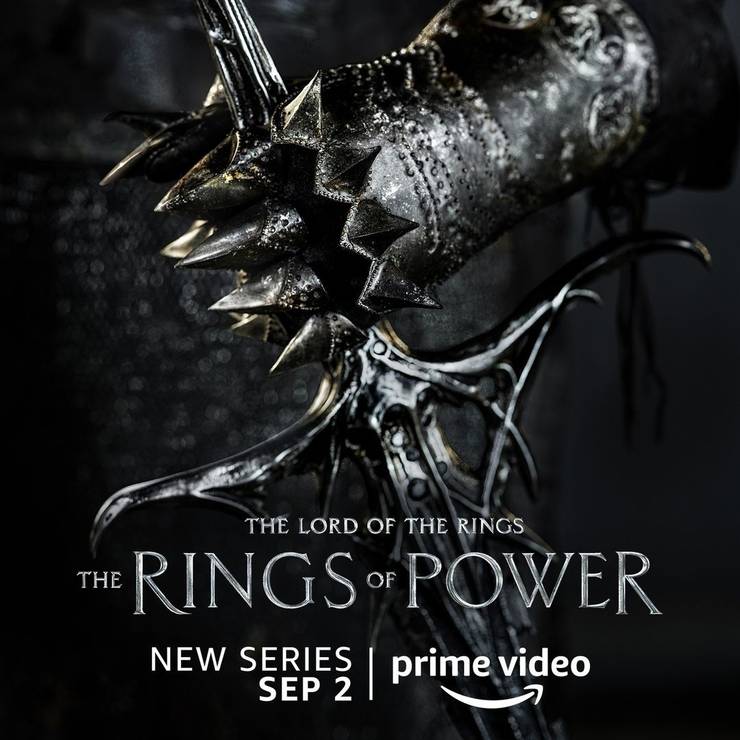|
|
Post by Deleted on Feb 3, 2022 14:30:17 GMT -5
So they have released character posters (which reveal the release date) for Lord of the Rings: The Rings of Power. However, it a (I think) clever twist, the posters show none of the characters faces, only the hands-and the rings of power they were for those who have the rings. The release date given is September 2. You can see all 17 posters here in the story at CBRbut here are a couple samples...   not all of them have rings, or even look high born...  and of course, the enemy...  I am intrigued by a lot of the posters as to who the characters they depict are. More intrigued than if I just saw the actors in costume. -M |
|
|
|
Post by Roquefort Raider on Feb 3, 2022 15:27:22 GMT -5
With nine rings going to mortal men, I hope we'll see more of the Haradrim and Easterlings... Their design in LotR was just amazing. While at least three or four of the Nazgul were Numenoreans, at least one (Khamul) is said to be a black Easterling (maybe that's him in one of the posters?)
I'd love to hear more about the regions east and south of Mordor, about which we know precious little. It would be good to explore them and to show, in the context of a multi-episode series that can take its time, how Sauron mostly gains allies by guile and seduction (Satan-like!) and not by raw force. I was not particularly interested in The Further Exploitation of Tolkien's Creation, to be honest, but this has the potential to be quite good indeed... if the original material is treated with respect. Fingers crossed. |
|
|
|
Post by berkley on Feb 3, 2022 15:32:21 GMT -5
A re-read of Tolkien will wreak havoc with my reading plans, but I starting to wonder if I shouldn't give the Silmarillion a run-through before this series starts.
|
|
|
|
Post by Deleted on Feb 11, 2022 15:14:15 GMT -5
Longish first look article with lots of preview pics of Rings of Power at Vanity FairNote VF is a pay site, but you can read x number of articles for free, so if you haven't reached the limit, you can read without paying. Some of the preview images...       -M |
|
|
|
Post by Deleted on Feb 13, 2022 22:19:25 GMT -5
First trailer dropped during the Super Bowl...
-M
|
|
|
|
Post by berkley on Feb 21, 2022 9:52:13 GMT -5
There was a Guardian article on the tv show a few days ago, and apparently it's based on the Appendices to The Lord of the Rings, not on the Silmarillion or any of the posthumous releases. And it seems the show will be telling new stories derived from that material, not necessarily adapting Tolkien's outlines or anything like that. That as the impression I was left with, at least.
|
|
|
|
Post by Deleted on Feb 25, 2022 13:16:59 GMT -5
Just cross-posting this with a link-I recently read The Art of the Lord of the Rings by JRR Tolkien and did a write up in the books thread-M |
|
Confessor
CCF Mod Squad
Not Bucky O'Hare!
Posts: 10,212 
|
Post by Confessor on Mar 16, 2022 7:11:55 GMT -5
 I re-read the chapter "The Ring Goes South" from The Lord of the Rings Book II last night and I wanted to get your thoughts on the vicious snow storm that prevents the fellowship from reaching Dimrill Dale across the Redhill Pass on the mountain Caradhras. Tolkien is never explicit on the precise cause of this snowstorm, but the fellowship discuss it being a) just a natural storm, b) the work of Sauron, c) the mountain itself trying to kill them. The first potential cause obviously needs little discussion – it's just bad luck. As for it being the work of Sauron, Boromir tells his companions that Sauron can affect the weather, and Gandalf seems to recognise the possibility that it might be the Dark Lord at work by saying, "his arm has grown long." If the storm was indeed caused by Sauron, I wonder if it was a deliberate attempt to drive the fellowship into Mines of Moria and the dangers lurking there – including the Balrog, or was it an attempt to kill them all right there on the mountain? The third possibility is, to my mind, the most intriguing. The mountain was known as "Caradhras the cruel" and clearly Gandalf entertains the idea of the Mountain itself being sentient. After all, much nature in the Third Age was still "alive"...trees, foxes, and maybe even the mountain itself? The fact that there is a huge snow drift blocking the heroes passage down the mountain as well as the storm blocking their way up certainly seems to suggest that the storm is the mountain's doing (although it could just as easily be attributed to Sauron, I suppose). But if it is Caradhras's doing, to what end? Is the mountain evil or is it just an ancient angry force like Old Man Willow? Myself, I like not knowing the real answer. Clearly, Tolkien deliberately left the storm's cause ambiguous because it heightens the level of menace and threat if the reader is as clueless as the players. But I just wondered what you all put the storm down to in your own minds? |
|
|
|
Post by berkley on Mar 16, 2022 10:17:02 GMT -5
It's been too long since I read it to recall what I felt at the time but I find myself leaning towards the ancient force of nature easily roused to anger, as it seems to fit with Tolkien's conception of Middle Earth. OTOH, they are getting closer to Mordor than in the Old Man Willow episode (if I remember that correctly), so Sauron's agency becomes more likely. I agree that the ambiguity is intentional and effective: even Gandalf can't say for sure, which heightens the tension and the general sense of being at the mercy of obscure but tremendous forces that are not easy to understand or deal with, whether evil in themselves or not.
|
|
|
|
Post by Deleted on Mar 16, 2022 11:25:12 GMT -5
To me it is Tolkien completely encapsulating the nature of myth (in an especially Campbellian way though)-this event happens and men struggle to ascribe meaning to it and its origins and purpose by telling stories (or conjecturing) about it, but none of the answers needs to be the right one. It happened. They whys and wherefores are only import to mankind as it is relevant to their place in the universe, but the event occurs regardless of man, not because of it. It is their ego that ascribes meaning to their presence in the sphere of an event.
A storm happens.
Is it just a storm?
No cries man, it happened because WE are here.
Why?
It's the evil overlord trying to stop US, so the storm happened because of us.
or
WE have angered the mountains by our presence, so the storm happened because of us.
Of course humorously, I just watched a youtube video on the craft of DMing that used this passage as an example of DM railroading-The DM had an adventure planned someplace (i.e. in the Mines of Moria). The party chose to avoid it (to go over the mountains), so the DM threw something (i.e. the storm) at them to prevent them from taking that path and going the way he wanted them to where he had the adventure planned.
I can sort of see Tolkien doing something similar. It makes more sense for them to avoid the Mines and take the mountain passes, who in their right mind would take the more dangerous path? But Tolkien wanted them to go through Moria and introduce that part of the lore he had constructed, so the attempt through the mountains was there to show why they would take, what seemed the more dangerous way initially, after all. The storm happened because it needed to happen for the narrative's sake. The justification doesn't really matter to the story or to anyone but the characters who struggle to find the meaning to them and their narrative in the storm.
-M
|
|
Confessor
CCF Mod Squad
Not Bucky O'Hare!
Posts: 10,212 
|
Post by Confessor on Mar 17, 2022 17:39:45 GMT -5
Further to my above post about the snow storm that plagued the fellowship on Redhill Pass on Caradhras, I looked the mountain up in Robert Foster's Complete Guide to Middle-earth. There it says that the mountain was called "Caradhras the cruel" by the Dwarves because of its harsh weather, not because the mountain was sentient, as I speculated. So, that perhaps adds a bit more evidence for it being just a natural snow storm. Though it's not definitive, obviously.
|
|
|
|
Post by Roquefort Raider on Mar 18, 2022 9:47:26 GMT -5
Further to my above post about the snow storm that plagued the fellowship on Redhill Pass on Caradhras, I looked the mountain up in Robert Foster's Complete Guide to Middle-earth. There it says that the mountain was called "Caradhras the cruel" by the Dwarves because of its harsh weather, not because the mountain was sentient, as I speculated. So, that perhaps adds a bit more evidence for it being just a natural snow storm. Though it's not definitive, obviously.
I think you were quite right, no matter what Foster might say. Places having quasi-sentience (if not an actual intelligence) do seem to pop up here and there in Tolkien's world; the Old Forest, for one, did feel like an actively hostile place when the Hobbits walked through it.
On a different subject... Re-reading The Tale of Years yesterday, I was reminded that Sauron had had the One Ring for nearly two thousand years during the second age. And yet during that time he was beaten twice; first, after initially taking over Eregion, he was pushed back to Mordor by a Numenorean invasion; then, during the reign of Ar-Pharazon, he was beaten so badly that the king actually took him back to Numenor as a prisoner. Granted, in the last case Sauron might have have seen such a captivity as a great opportunity to corrupt the Edain, but overall I was a bit taken aback by how little difference there was between a Sauron with the One Ring and a Sauron without.
|
|
|
|
Post by Deleted on Mar 18, 2022 19:03:57 GMT -5
|
|
|
|
Post by berkley on Mar 18, 2022 20:09:34 GMT -5
Further to my above post about the snow storm that plagued the fellowship on Redhill Pass on Caradhras, I looked the mountain up in Robert Foster's Complete Guide to Middle-earth. There it says that the mountain was called "Caradhras the cruel" by the Dwarves because of its harsh weather, not because the mountain was sentient, as I speculated. So, that perhaps adds a bit more evidence for it being just a natural snow storm. Though it's not definitive, obviously.
I think you were quite right, no matter what Foster might say. Places having quasi-sentience (if not an actual intelligence) do seem to pop up here and there in Tolkien's world; the Old Forest, for one, did feel like an actively hostile place when the Hobbits walked through it.
On a different subject... Re-reading The Tale of Years yesterday, I was reminded that Sauron had had the One Ring for nearly two thousand years during the second age. And yet during that time he was beaten twice; first, after initially taking over Eregion, he was pushed back to Mordor by a Numenorean invasion; then, during the reign of Ar-Pharazon, he was beaten so badly that the king actually took him back to Numenor as a prisoner. Granted, in the last case Sauron might have have seen such a captivity as a great opportunity to corrupt the Edain, but overall I was a bit taken aback by how little difference there was between a Sauron with the One Ring and a Sauron without.
I haven't read the Tales of Years but I remember having similar feelings wherever I came across this info - must have been either the Silmarillion or the appendices to the original trilogy. I took it as an indication of how powerful the kings of Numenor were at their height as compared with the time of the action in LotR but it still seemed strange that Sauron would allow himself to be taken prisoner. |
|
|
|
Post by berkley on Mar 18, 2022 20:12:10 GMT -5
I'm a big fan of Tolkien's artwork - in fact, I find almost all other illustrators of his work to feel off the mark to me because my vision of Tolkien's world has become so tied to his own drawings of Middle Earth. |
|